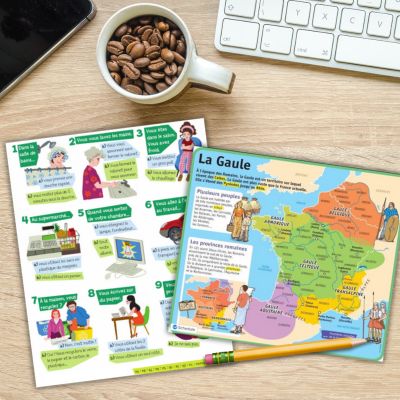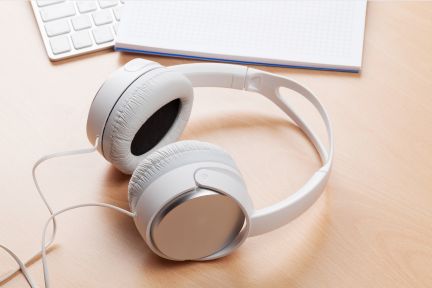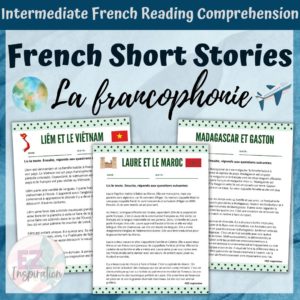
Learning a language involves more than just memorizing vocabulary and mastering grammar rules. To truly immerse oneself in the linguistic and cultural richness of a language, it is essential to incorporate authentic French reading materials into the learning process. By using genuine, real-world French reading materials, students become more engaged in their reading process, making the learning experience more enjoyable and effective for enhancing language proficiency. In this blog, we will identify seven creative French reading materials that you can incorporate into your classroom today.
1. French Infographics
Using French infographics can be a highly effective and engaging way to enhance reading proficiency among French learners. Infographics combine visual elements with concise information, making them an ideal tool for improving reading comprehension, vocabulary, and overall French proficiency.

When using infographics as French reading materials in the classroom, it is important to:
-
- Select relevant and interesting infographics that align with your students’ interests and proficiency level
- Include pre-reading activities to activate students’ prior knowledge on the chosen topic and highlight key vocabulary that is embedded within the infographic
- Discuss any relevant vocabulary or key concepts that appear in the infographic
- Encourage students to make inferences with the infographic and discuss the layout and design to help students understand the link between the visual cues and textual information
5. Facilitate group discussions where students can share their interpretations of the infographic
6. Follow up with comprehension questions to examine students’ knowledge and application skills
You can find an array of French infographics on Pinterest or by using Google Search. I have pinned a variety of infographics that I use in my classes, especially my AP French classes. You can find some infographic inspiration here.
2. Francophone Song Lyrics -
Integrating francophone musique into your classroom can be another creative and engaging way to enhance reading proficiency among learners. In particular, analyzing song lyrics can help students understand slang, idioms, and various aspects of French culture. Students are also able to identify different grammatical structures and see these concepts in practice.

When analyzing francophone musical lyrics, it is important to:
-
- Choose songs that are not only linguistically rich but also culturally significant. You can pick a specific song that highlights a certain grammar concept or theme
- Select age-appropriate songs that appeal to different musical genres and student interests
- Make sure to introduce the artist, the song’s genre, and background ahead of time
- Discuss any unfamiliar vocabulary or cultural references that may appear in the lyrics
- Provide students with a printed copy of the song lyrics or display them on a screen.
- Encourage students to read the lyrics individually and underline or highlight words or phrases that they find challenging
- Allow opportunities for vocabulary exploration
- Play the song after the lyric analysis and have students listen actively for comprehension
- Facilitate group discussions on the meaning and interpretation of the lyrics.
Music has been such an empowering tool in my classroom and has such a dynamic and impactful approach to language acquisition. Not only does it have the ability to enhance oral comprehension but it also extends seamlessly into the realm of reading and creates a captivating experience for students to engage with the lyrics.
3. French Blogs

Incorporating modern and current French blogs and online articles into your daily lessons is another wonderful way to provide a more authentic language approach to learners. These digital entries combine text, images, videos and links to share a variety of content to learners.
When featuring French blogs in the classroom, you will want to pick topics that align with your students’ interests, whether it’s sports, travel, technology, or pop culture. Reading online content
exposes students to contemporary language use and colloquial expressions as well as enhances engagement as learners can explore content that genuinely interests them.
If you are looking for some authentic French blogs to improve your students French proficiency and reading comprehension, here are a couple of my favorites:
- French Crazy – This blog lives up to its name. It explores French culture, life, music, food and more. Have your students become obsessed with everything French!
- Talk in French – this blog allows learners to explore the French language, gain cultural insights, and learn how to become fluent in the language along the way!
- GreenPeace – Completing an environment unit with your students? Have students that are passionate about raising awareness about environmental issues? This blog is for you! It covers a vast amount of environmental issues and topics that are very informative to students
- Le Bondy Blog – interested in native French blogs? This blog is perfect for advanced and senior French learners and explores a variety of national issues such as international affairs, politics, society, culture, and more.
4. French Magazines
Magazines offer another unique opportunity to present students with French reading materials in the classroom. Magazines cover a wide range of topics and the diverse subjects allow learners to explore language and vocabulary related to their personal interests. This makes the learning experience more relevant and enjoyable.
Furthermore, magazines often include an array of images, infographics, and illustrations. These visual aids can help learners comprehend content, infer meaning from context, and reinforce vocabulary through associations with images.

If you are interested in using magazines as French reading material in your classroom, here are a couple of ones that I recommend:
- Mon quotidien – this newspaper is perfect for pre-adolescents and contains a variety of diverse articles in PDF format online. Students will be able to explore culture, space, politics, international issues, history, and more.
- Sports & Vie – are your students obsessed with sports? This magazine targets the world of sports and also includes informative articles about nutrition, psychology, and fitness.
- Elle – are your students into the latest fashion trends or beauty-obsessed? This fashion magazine covers a variety of topics related to fashion, beauty, lifestyle, and culture. Get up to date on the latest trends, style, and beauty advice.
- Voici – are your students into celebrities? This magazine might be up their alley. Voici covers a wide range of celebrity gossip and includes simple language that will increase their knowledge of celebrity culture.
One important thing to keep in mind is that not all content in magazines may be age-appropriate for your students. Try to look through the magazines in advance and pick out material that you think would appeal to your students’ interests and proficiency level.
5. French Signs

Present a variety of authentic French signs to your students. Signs cover a wide range of topics, from street names and directions to warnings and informational signs. This creative French reading material exposes students to diverse vocabulary that goes beyond what they might find in their traditional classroom, contributing to a more comprehensive language education.
If you’re interested in exploring a variety of French signs, here are a couple recommendations:
-
- License plates – explore the unique Québécois license plate
- Street Signs
- Metro Maps and Signs
- Cultural posters on a variety of French cultural icons, traditions and historical figures
- Famous quotes from famous francophones to inspire and provoke thought
- Menu du jour – present an authentic French restaurant’s menu to your students and allow them to discover a variety of popular dishes and beverages
- Advertisements – analyze and discuss French advertisements to understand marketing strategies and cultural influences
Reading signs provide students with an opportunity to engage with authentic, real-world language use. Signs are a part of our daily lives and students will gain insights about French culture, social norms, and the way information is conveyed in various contexts.
6. French Comic Books
Introduce your students to the world of French comic books, known as “les bandes dessinées.” These books combine visuals with text, making them an excellent choice for language learners. Comic books offer a rich language experience and have the opportunity to offer cultural content to students.
If you’re interested in sharing French comic books with your students, feel free to explore the classics such as “Les aventures de Tintin” which is a popular option among young francophone children and has gained popularity internationally as well. Tintin is a cartoon character who travels the world as an investigative reporter in the service of truth and justice. This comic series was originally created in 1929 and was one of the most popular European comics of the 20th century!

Astérix is another classical comic book series that was created by René Goscinny in 1959. The series features the adventures of a small village of Gauls who resist Roman occupation during the time of Julius Caesar. The central characters are Astérix, the clever warrior and his strong friend Obélix. This series would be a hit for your history loving students!
7. French Short Stories
Using collections of short stories that cover a range of themes and genres will play a pivotal role in fostering linguistic proficiency among students. Short Stories are great French reading materials that incorporate diverse narratives that can spark classroom discussions and allow students to explore cultural contexts. These texts can also be used for reading comprehension activities and assessments to gauge student understanding and promote critical thinking skills.
If you’re ever looking for engaging French reading comprehension texts, these are a couple of my favorites geared toward French intermediate learners:
In addition, feel free to check out these free texts to teach la francophonie in your classroom!
Keep in mind that you will want to foster reading strategies for students when introducing French Short Stories. These strategies are essential for promoting comprehension, critical thinking, and language acquisition. They will also foster an environment that encourages discussions and reflections on the stories for further engagement
French Reading Material Conclusion
In conclusion, using creative French reading materials in the classroom has the power to boost student engagement along with enhancing French proficiency at the same time. Diverse and authentic content not only exposes students to the richness of the French language but also fosters a genuine appreciation for the culture.
As you incorporate these creative French reading materials in your classroom, you’ll witness the transformative impact they have on language acquisition. Over time, you’ll curate your own personal trove of these resources, becoming a valuable repository that you’ll consistently draw upon to inspire and educate. By fostering a love for authentic French reading, you’re not just imparting language skills; you’re cultivating a lifelong passion for exploration and understanding, enriching your students’ linguistic journey in ways that extend far beyond the classroom.





